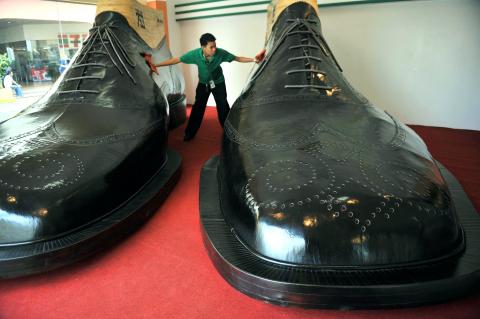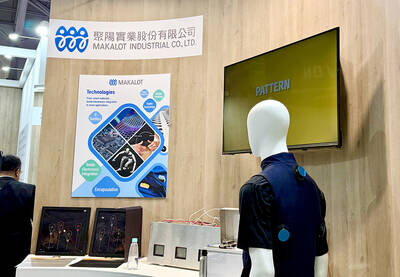A museum displaying the famed shoe collection of ex-first lady Imelda Marcos has reopened in the Philippines, heralding a fightback by its beleaguered shoe industry against a flood of cheap imports.
The museum is not just a showcase of the best of Marcos’ 3,000-pair collection, but also of the craftsmanship in shoe-making in the riverside eastern suburb of Marikina where the industry was born over a century ago.
Footwear consultant Tessie Endriga said that Marcos failed to provide the Marikina shoe industry with much-needed infrastructure or financing when her husband was in power. However, she did help in her own way.

Photo: AFP
“She did patronize local brands. If she liked a certain style, she would buy a dozen pairs,” said Endriga, who has worked with the government’s Bureau of Product Standards.
Marikina shoes were once famous, until low-priced footwear from countries like China and Vietnam flooded the industry over the years, local business leader Jose Tayawa said.
“You buy Marikina-made shoes and use them for five years. You buy Chinese shoes for one-fifth the price, but you can only use them for a few months,” said Tayawa, the head of the Marikina Chamber of Commerce and Industry.
Former shoe museum curator Dolly Borlongan conceded that most of Marcos’ shoes were imported, but added that there are many Marikina shoes among them, as well as displays on Marikina’s shoe-making history.
The museum was set up in 1998 as just one more way for Marikina to advertise its century-long history of making footwear, from humble slippers to rugged work boots to high-fashion custom shoes.
The town has also built the world’s largest shoes — a pair of leather men’s shoes, each as large as a van — which are still on display at a Marikina mall.
Generations of Filipinos grew up wearing the local products, and Marikina-made snake-skin shoes became the toast of Manhattan’s Fifth Avenue in the early-1980s, the city boasts on its Web site.
However, Marikina’s shoe--makers — and the shoe museum — have suffered setbacks in recent years. Massive flooding from Tropical Storm Ketsana last year damaged the museum, as well as many shoe-makers’ facilities and inventory.
The storm and the foreign competition took their toll. From the mid-1990s peak of 3,000, only about 200 Marikina shoemaking factories remain, said Roger Py, director-general of the Philippine Footwear Federation.
However, late last month, the museum reopened, just one of the moves that Marikina officials and businessmen hope will turn the footwear industry around, city administrator Victoriano Sabiniano said.
Tourists who visited the museum tended to look for a place to buy Marikina shoes, officials said, so the city is setting up a permanent shoe expo in a central area to sell its key product and spread the word about its quality.
“Step one is the local market. Once we fix that, we can go abroad,” Sabiniano said.
Quality was never the problem, Endriga said.
“We have come up with excellent shoes. The quality of craftsmanship in the Philippines can compete with Italy,” she said.
However, “I won’t say the shoe industry is dying, but it is missing out on a lot of opportunities,” she said.
Government figures show that Philippine footwear exports last year dropped 19.5 percent over the previous year to US$25.96 million.
Exports hit their peak at US$176.3 million in 1994, but have fallen sharply over the years.
Many visiting foreign buyers are still impressed by the quality of Philippine footwear, said Merlinda Diaz, an officer in the government’s Bureau of Export Trade Promotion.
“But then they ask for China-level prices and the deal falls through,” Diaz said.
The solution is not to compete with the high-volume production of these countries, he said.
“We avoid meeting the competition head-on in the cheap footwear sector. We go for the middle and the high-end,” said Py, who also heads Stefano Footwear, a major local manufacturer.
The local cobblers are now targeting smaller boutique stores in developed countries, where low prices are not the main attraction, he said.
The rising wages in China are also making Marikina shoes more competitive, Py added.

Shares in Taiwan closed at a new high yesterday, the first trading day of the new year, as contract chipmaker Taiwan Semiconductor Manufacturing Co (TSMC, 台積電) continued to break records amid an artificial intelligence (AI) boom, dealers said. The TAIEX closed up 386.21 points, or 1.33 percent, at 29,349.81, with turnover totaling NT$648.844 billion (US$20.65 billion). “Judging from a stronger Taiwan dollar against the US dollar, I think foreign institutional investors returned from the holidays and brought funds into the local market,” Concord Securities Co (康和證券) analyst Kerry Huang (黃志祺) said. “Foreign investors just rebuilt their positions with TSMC as their top target,

REVENUE PERFORMANCE: Cloud and network products, and electronic components saw strong increases, while smart consumer electronics and computing products fell Hon Hai Precision Industry Co (鴻海精密) yesterday posted 26.51 percent quarterly growth in revenue for last quarter to NT$2.6 trillion (US$82.44 billion), the strongest on record for the period and above expectations, but the company forecast a slight revenue dip this quarter due to seasonal factors. On an annual basis, revenue last quarter grew 22.07 percent, the company said. Analysts on average estimated about NT$2.4 trillion increase. Hon Hai, which assembles servers for Nvidia Corp and iPhones for Apple Inc, is expanding its capacity in the US, adding artificial intelligence (AI) server production in Wisconsin and Texas, where it operates established campuses. This

US President Donald Trump on Friday blocked US photonics firm HieFo Corp’s US$3 million acquisition of assets in New Jersey-based aerospace and defense specialist Emcore Corp, citing national security and China-related concerns. In an order released by the White House, Trump said HieFo was “controlled by a citizen of the People’s Republic of China” and that its 2024 acquisition of Emcore’s businesses led the US president to believe that it might “take action that threatens to impair the national security of the United States.” The order did not name the person or detail Trump’s concerns. “The Transaction is hereby prohibited,”

Garment maker Makalot Industrial Co (聚陽) yesterday reported lower-than-expected fourth-quarter revenue of NT$7.93 billion (US$251.44 million), down 9.48 percent from NT$8.76 billion a year earlier. On a quarterly basis, revenue fell 10.83 percent from NT$8.89 billion, company data showed. The figure was also lower than market expectations of NT$8.05 billion, according to data compiled by Yuanta Securities Investment and Consulting Co (元大投顧), which had projected NT$8.22 billion. Makalot’s revenue this quarter would likely increase by a mid-teens percentage as the industry is entering its high season, Yuanta said. Overall, Makalot’s revenue last year totaled NT$34.43 billion, down 3.08 percent from its record NT$35.52